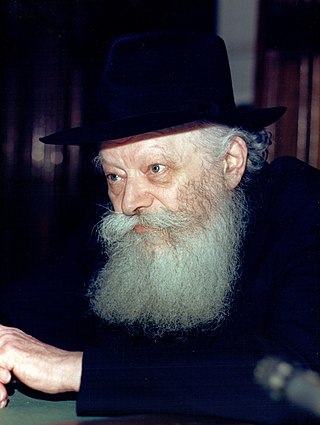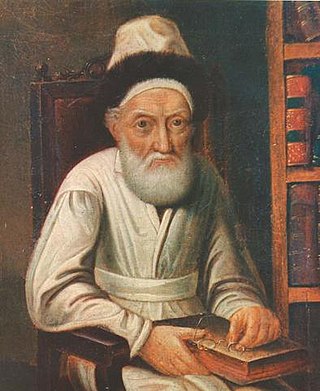
Menachem Mendel Schneerson, known to adherents of the Chabad-Lubavitch movement as the Lubavitcher Rebbe or simply the Rebbe, was a Russian-American Orthodox rabbi and the most recent Rebbe of the Lubavitch Hasidic dynasty. He is considered one of the most influential Jewish leaders of the 20th century.

Chabad, also known as Lubavitch, Habad and Chabad-Lubavitch, is a branch of Orthodox Judaism, originating from Eastern Europe and one of the largest Hasidic dynasties. Chabad is one of the world's best-known Hasidic movements. It is one of the largest Hasidic groups as well as one of the largest Jewish religious organizations in the world. Unlike most Haredi groups, which are self-segregating, Chabad mainly operates in the wider world and it caters to secularized Jews.

Menachem Mendel Schneersohn also known as the Tzemach Tzedek was an Orthodox rabbi, leading 19th-century posek, and the third rebbe of the Chabad Lubavitch Hasidic movement.

Yosef YitzchakSchneersohn was an Orthodox rabbi and the sixth Rebbe of the Chabad Lubavitch Hasidic movement. He is also known as the Frierdiker Rebbe, the Rebbe RaYYaTz, or the Rebbe Rayatz. After many years of fighting to keep Orthodox Judaism alive from within the Soviet Union, he was forced to leave; he continued to conduct the struggle from Latvia, and then Poland, and eventually the United States, where he spent the last ten years of his life.

Schneersohn is a Jewish surname used by many of the descendants of Rabbi Shneur Zalman of Liadi, the first Rebbe of the Chabad-Lubavitch Hasidic movement.

Sholom Dovber Schneersohn was the fifth rebbe of the Chabad-Lubavitch chasidic movement. He is known as "the Rebbe Rashab". His teachings that encouraged outreach were further developed later.

Kehot Publication Society is the publishing division of the Chabad-Lubavitch movement.

Chaya Mushka (Moussia) Schneerson, referred to by Lubavitchers as The Rebbetzin, was the wife of Menachem Mendel Schneerson, the seventh and last rebbe of the Chabad-Lubavitch branch of Hasidic Judaism. She was the second of three daughters of the sixth Lubavitcher rebbe, Yosef Yitzchok Schneersohn. She was named after the wife of the third Lubavitcher rebbe, Menachem Mendel Schneersohn.

Rabbi Yehuda Chitrik was an author and Mashpia in the Chabad Hasidic community in Brooklyn, New York.

Shemaryahu Gurary, also known by his Hebrew initials as Rashag, (1897–1989) was a rabbi following the Chabad-Lubavitch dynasty of Hasidism. His father was Menachem Mendel Gurary. He was a son-in-law of Yosef Yitzchok Schneersohn, the sixth Chabad-Lubavitch rebbe, and the brother-in-law of Menachem Mendel Schneerson, the seventh. He worked with his father-in-law in Russia and Poland and moved to the U.S. in 1940.
Barry Gurary was a rabbi. He was the nephew of Rabbi Menachem Mendel Schneerson, the seventh Lubavitcher rebbe.

A farbrengen is a Hasidic gathering. This term is only used by Chabad-Lubavitch Hasidim, as other Hasidim have a tish or a botteh. It may consist of explanations of general Torah subjects, with an emphasis on Hasidic philosophy, relating of Hasidic stories, and lively Hasidic melodies, with refreshments being served. It is regarded as a time of great holiness. Farbrengens are public events open to non-Hasidim as well.

3 Tammuz or Gimmel Tammuz is a holiday on the Chabad-Lubavich calendar that marks the anniversary of the passing of Rabbi Menachem Mendel Schneerson, the seventh Rebbe of the Chabad-Lubavitch Hasidic dynasty. Rabbi Schneerson passed away on June 12, 1994, corresponding to 3 Tamuz 5754 in the Hebrew calendar. The day is observed by followers of Chabad-Lubavitch as a time for reflection on the Rebbe's teachings and legacy.

Chabad offshoot groups are those spawned from the Chabad Hasidic Jewish movement. Many of these groups were founded to succeed previous Chabad leaders, acting as rivals to some of the dynastic rebbes of Chabad. Others were founded by former students of the movement, who, in forming their own groups, drew upon their experiences at Chabad.

Machne Israel is the social service organization of the Chabad-Lubavitch movement.

Chabad philosophy comprises the teachings of the leaders of Chabad-Lubavitch, a Hasidic movement. Chabad Hasidic philosophy focuses on religious concepts such as God, the soul, and the meaning of the Jewish commandments.

Chabad customs and holidays are the practices, rituals and holidays performed and celebrated by adherents of the Chabad-Lubavitch Hasidic movement. The customs, or minhagim and prayer services are based on Lurianic kabbalah. The holidays are celebrations of events in Chabad history. General Chabad customs, called minhagim, distinguish the movement from other Hasidic groups.

Dirah betachtonim (Hebrew: דירה בתחתונים, romanized: dirā bəṯaḥtonim, lit. 'a dwelling in the lowly realms' is a significant theological concept in Chabad philosophy describing the ultimate desire of God as relating to the manifestation of the divine presence within the material world.
Shaina Horenstein was the youngest daughter of Rabbi Yosef Yitzchak Schneersohn, the sixth Rebbe of the Chabad Hasidic movement. In the Chabad community, she is referred to as Rebbitzin Shaina.

Yisroel Jacobson (1895-1975) was a Chabad Hasidic rabbi and the representative of the sixth Chabad rebbe, Yosef Yitzchak Schneersohn, to the United States during the 1920s and 1930s. He was one of the first Lubavitcher activists to arrive in to the United States. He was born in Russia and migrated to the United States in 1925.









